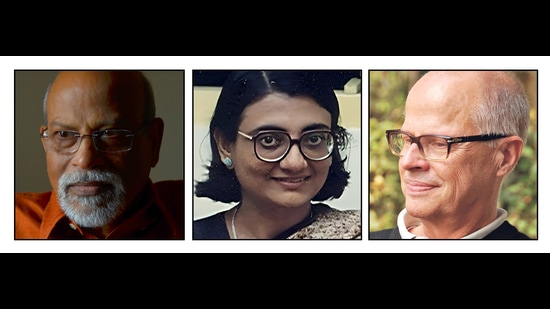A young woman is dragged away by a crocodile, only to mysteriously resurface a decade later, married to the reptile. A pet goat is let loose in a government office, by a rebellious employee. A lout saves his village from a flood. A bullock-cart driver is torn between tradition and modernity.
Odisha comes to life in The Greatest Odia Stories Ever Told, a collection of 24 traditional and contemporary Odia tales selected and translated by Leelawati Mohapatra, Paul St-Pierre, and KK Mohapatra. One of the stories dates back to 1898, others were written as recently as 1999.
There are short stories by masters such as Fakir Mohan Senapati, Gopinath Mohanty, Reba Ray and contemporary voices such as Pratibha Ray and Nrusingha Tripathi.
Senapati’s Rebati, about a young village girl desperate for an education, was written in 1898 and is widely considered the first short story in Odia literature. Before this, longer prose and poetry dominated. Reba Ray’s Sanyasi, written in 1899, is recognised as the first Odia short story by a woman. It tells of a man so disturbed by the unrest in his home and the death of his wife, that he leaves the world behind to become a sanyasi.
In Manoj Das’s Mrs Crocodile, written in 1975, a Western anthropologist visits a primitive village, and seeks out and listens riveted to the story of a woman who is said to have married a crocodile. The story’s narrator and the anthropologist’s interpreter is a local youngster who is now in a modern school and believes such things are silly.
Excerpts from an interview with Leelawati Mohapatra, Paul St-Pierre and KK Mohapatra (who chose to answer collectively rather than individually).

What was the aim in representing these short-story traditions?
The main concern was to show how the modern Odia short story, a genre that has grown over a period of a century and a quarter, has remained rooted in tradition while being transformed, how it has absorbed influences without becoming alienated from its milieu. The majority of the stories chosen deal with society in the inexorable grip of transition. They explore the beauty as well as the brutality of life.
Which are your favourite characters from among those in these stories?
There are many characters we liked individually and collectively. The one character all three of us plumped for was Ananta of Senapati’s 1913 story, Ananta, The Widow’s Boy, an overgrown, loutish brat, who saves the day when his village is about to be submerged. He plugs a widening breach in an embankment by pressing his own body against it, and risks being buried in the mud in the process.
We liked Dadhibaman from Mohanty’s 1957 tale The Solution, the hapless and harried clerk who erupts in a dire act of rebellion and lets his pet goat chew up the office files piling up on his desk.
Our hearts went out to Mulgi (of Rabi Patnaik’s 1979 tale Savitri), who sacrifices herself to save her husband. [Mulgi agrees to have sex with a policeman in exchange for his release, after he was detained without cause.]
They all, in their way, display the triumph of the human spirit.
How would you characterise the Odia narrative style?
Since 1898, there has been a kind of restless experimentation with technique and narrative in the Odia short story. The social landscape began to change rapidly, as did the physical. Towns sprang up. Economic activity boomed. Bureaucracy gave rise to newer and varied forms of employment, spurring education. New elites appeared on the scene. Literature, which made a transition from the chiefly oral to the written word, had to grapple with complex forms of relationships, exploitation, encroachments and divides, and make sense of a growing alienation.
It had to chronicle the rapidly fragmenting individual psyche, define the anxiety of coping with a fast-changing world that appeared hostile and incomprehensible. Therefore the narrative style could not be one, but many. No longer did linear story-telling find favour with all authors and audiences.
What is the sense of Odia culture from a century ago that you get from these stories?
One develops an unmistakable sense of nostalgia. Problems have multiplied. The tranquility of an agrarian, pastoral life is gone. Gone too is the old feeling of communal harmony. Life has become more complex, competitive and bitter. The Odia society of 100 years ago can only be glimpsed in the fiction of our older writers. The new society hardly retains the charm and snugness of the old.
Which of the stories was most difficult to translate?
Easily those that had a lot to do with cultural specifics. Chandrasekhar Rath’s The Tale of the Snake Charmer from 1991 and Pratibha Ray’s Salvation from 1993, more than the others, have such a wealth of arcane words and expressions that we struggled a lot to find English equivalents. Preserving their nuances was a challenge.
In Rath’s story are copious references to snakes, snake skins and characteristics, which we had to grapple with. In Ray’s story, the arcane customs governing the relationship between a man and his wife’s elder sister, which might be obvious to the Odia reader, had to be explained for the benefit of the non-Odia audience.
Enjoy unlimited digital access with HT Premium
Subscribe Now to continue reading

Stay connected with us on social media platform for instant update click here to join our Twitter, & Facebook
We are now on Telegram. Click here to join our channel (@TechiUpdate) and stay updated with the latest Technology headlines.
For all the latest Art-Culture News Click Here
